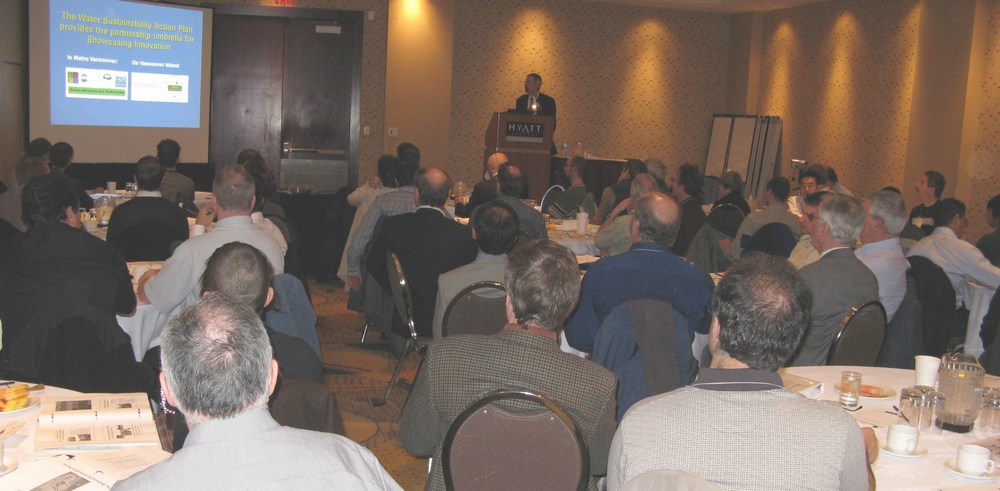2007 Beyond the Guidebook Seminar: Green Infrastructure message resonates with British Columbia engineers
Beyond the Guidebook: Context for Rainwater Management & Green Infrastructure in British Columbia
Released in June 2007, “Beyond the Guidebook” refers to a runoff-based approach to drainage modeling that connects the dots between source control evaluation and stream health assessment. In a nutshell, it means this is ‘where science meets analysis’ because runoff volume management is directly linked to stream erosion and water quality.
Under the umbrella of the Water Sustainability Action Plan for British Columbia, the Green Infrastructure Partnership rolled out Beyond the Guidebook at a seminar held in Vancouver in November 2007. Because the Green Infrastructure Partnership includes the Ministry of Community Services and Fisheries and Oceans Canada, this provided a timely opportunity to inform local government and land use practitioners regarding the emerging policy framework and senior government expectations for applying a Beyond the Guidebook approach to land development and watershed management.
Seminar Design
The seminar was structured in three parts to deal with the Why, What and How in going Beyond the Guidebook. Links to the set of PowerPoint presentations are listed below.
The seminar also enabled the Green Infrastructure Partnership to report out on provincially funded programs and tools that are being developed and implemented through partnerships, with notable examples being the Showcasing Green Infrastructure Innovation Series and the Water Balance Model powered by QUALHYMO.
In addition, the City of Surrey created a knowledge-transfer group exercise based on the Fergus Creek watershed plan, which is the provincial pilot for Beyond the Guidebook. The purpose of the exercise was to engage practitioners so that they would focus on the practical aspects of implementiing changes in land development practices.
To download a copy of the agenda, click on Seminar Program; and to download a copy of the program objectives, click on Seminar Learning Outcomes.
Province-wide Audience
“The response by the engineering community and others was overwhelming, and came as a welcome surprise,” reports Paul Ham, Chair of the Green Infrastructure Partnership .
Attendance was capped at 72 and there was a waiting list. “We were at capacity two weeks before the event. If we had the option to switch to a larger venue, we would have filled it,” adds Kim Stephens, the seminar moderator and the Program Coordinator for the Action Plan,
“We squeezed as many people as we could into the room. Clearly, there is a strong practitioner interest in learning more about rainwater management and green infrastructure, and understanding the emerging regulatory framework.”
Although the majority of attendees came from Metro Vancouver and the Fraser Valley, the seminar attracted a province-wide audience. There was a large contingent from Vancouver Island. Attendees also came from as far away as Prince George and the Okanagan.
Part A (Why) – Green Infrastructure Innovation: On-the-Ground Successes
The learning outcome for Part A was that participants would be able to express why showcasing on-the-ground successes will help chnage the way we develop land and manage rainwater runoff.
Paul Ham (City of Surrey), Chair of the Green Infrastructure Partnership presented Who is Doing What in the Georgia Basin: Showcasing Innovation to set the scene for presentations by the members of Team A . The focus of Paul’s presentation was on the Showcasing Green Infrastructure Innovation Series which comprised parallel series in Metro Vancouver and on Vancouver Island in 2007.
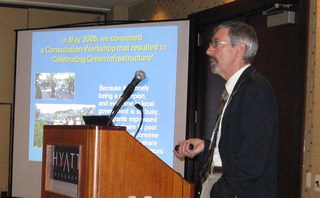
Raymond Fung (District of West Vancouver), Chair of the BCWWA Water Sustainability Committee then kicked off an audience interaction segment with a short presentation titled Green Infrastructure Roundtable: Sharing Lessons Learned
Raymond Fung was joined by Richard Boase (District of North Vancouver) and David Desrochers (City of Vancouver) in asking the audience “So, what is your story?”. To engage the audience, David presented a multi-media package titled Sustainable Design.
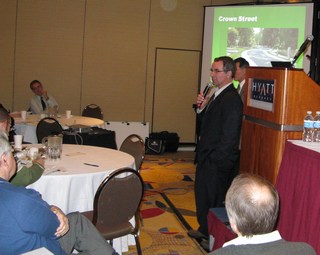
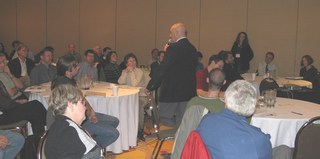
With the first of three presentaton segments by Jim Dumont (designated by the Inter-Governmental Partnership as the Engineering Authority for the Water Balance Model) , the day moved from storytelling into the technical content. His presentation was titled Beyond the Guidebook: Why the Water Balance Model Powered by QUALHYMO.This provided an opportunity to announce that British Columbia, Alberta and Ontarion have formed an Inter-Provincial Partnership to promote Canada-wide use of the national Water Balance Model as a tool to facilitate ‘green’ development practices.
Part B (What) – Beyond the Guidebook: Applying What We Have Learned to Protect Stream Health
The learning outcome for Part B was that participants would be able to express why there is a shift in thinking from single-function stormwater management to integrated and comprehensive rainwater management.
Chris Jensen (Ministry of Community Services), Co-Chair of the Water Balance Model Vancouver Island Coordinating Team (VICT) was the leader of Team B which was tasked with explaining the regulatory and legal framework. Chris opened Part B with a presentation titled Integration of Rainwater Management and Green Infrastructure: The Province’s Perspective. In his presentation, and for the purposes of establishing a frame of reference, Chris provided a contrast with Washington State. To read a previous story that elaborates on the observation that Washington State and British Columbia are on diverging paths, click here.
Corino Salomi (Fisheries and Oceans Canada), representing both the Green Infrastructure and Water Balance Model partnerships, then followed with a presentation titled Moving from Stormwater Management to RAINwater Management: A DFO Perspective.
Susan Rutherford (West Coast Environmental Law), also a member of the Green Infrastructure Partnership Steering Committee, rounded out Part B with a presentation on Implementing Legal and Policy Actions to Support Green Infrastructure. The focus of Susan’s presentation was on the Green Infrastructure Guide, published in 2007.
Part C (How) – A Pilot for Beyond the Guidebook: City of Surrey’s Fergus Creek Watershed Plan
The learning outcome for Part C was that participants would be able to express how green infrastructure policies and practices can be successfully implemented at the site scale to protect stream health at the watershed scale. Part C was organized as a ‘mini-charrette’, and participants worked in groups to resolve ‘how to do it’ implementation issues related to four (re)development scenarios.
Jim Dumont set the stage with a presentation titled Fergus Creek Analysis: Technical Findings . His objective was to provide the breakout groups with a basic understanding of the considerations shaping the rainfall-runoff modelling and how this correlates with stream health.
Remi Dube (City of Surrey) then outlined the ‘rules of engagement’ for the breakout session with a presentation titled Fergus Creek Watershed: Opportunities & Constraints. His objective was to provide an understanding of how to apply Jim Dumont’s engineering findings to the land development scenarios.
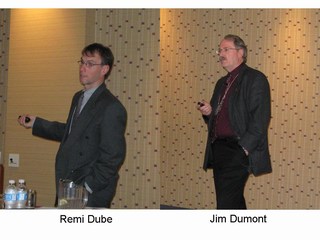
After the breakout groups reported out, Jim Dumont wrapped up by explaining the strategy actually adopted by the City of Surrey: The Strategy Selected for Fergus Creek
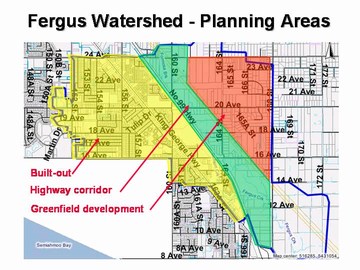
For more information on the Fergus Creek pilot, click on Showcasing Innovation in Surrey which was the second event in the 2006 Showcasing Green Infrastructure Innovation Series.
Breakout Group (Charrette) Session
The audience primarily comprised engineers (about 80%), with a sprinking of planners and biologists to provide an interdisciplinary mix in the charrette segment.
“Having engineers do a plannning exercise was brilliant,” observed Carolyn Drugge of the City of Vancouver’s Engineering Department, “It was fun and inspirational to be part of the process.”
“I never thought I would see the day when a group of engineers would actually say we need a planner,” added Darcey Kohuch, Director of Engineering for the District of Sooke, “But that is what happened in our breakout group when we were trying to think like planners in doling the land use planning for our development scenario.”
The plenary session was facilitated by Karen Rothe of the Ministry of Community Services.
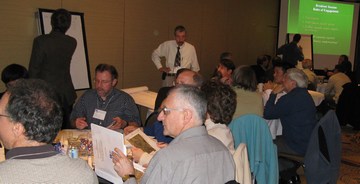

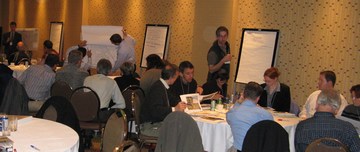
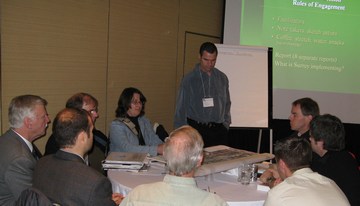
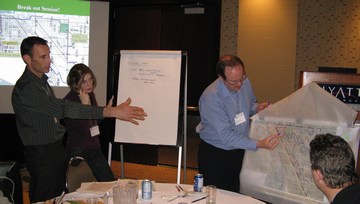
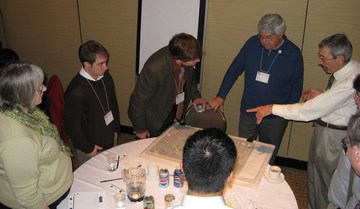

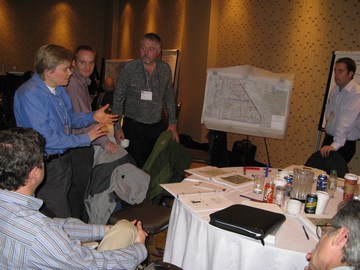
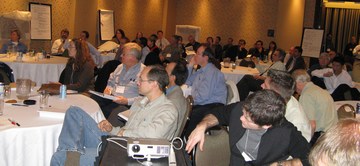
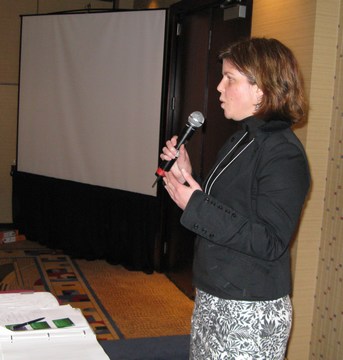
A Transformational Event?
Kim Stephens provided this perspective on what he believes was accomplished by the seminar: “We started the day with high expectations that the Beyond the Guidebook Seminar would prove to be a transformational event, and we exceeded those expectations as the day unfolded.”
 “Further, my prediction is that this event will become part of our green infrastructure folklore, much as the 2005 REAC Consultation Workshop and the 1997 Union of BC Municipalities focus group workshop were defining moments in moving British Columbia down a pathway that led to the Beyond the Guidebook Seminar.”
“Further, my prediction is that this event will become part of our green infrastructure folklore, much as the 2005 REAC Consultation Workshop and the 1997 Union of BC Municipalities focus group workshop were defining moments in moving British Columbia down a pathway that led to the Beyond the Guidebook Seminar.”
“It is the telling of the story about an event that takes on importance in moving practitioners from talk to action,” added Stephens, “A key is that those who were there come away inspired and start doing things differently in their day jobs as a result of what they learned by being part of the moment.”
Original story posted on the Green Infrastructure Community-of-Interest in November 2007



